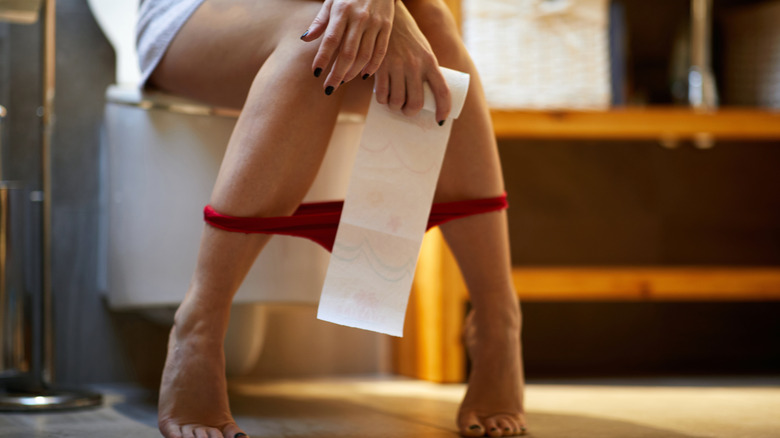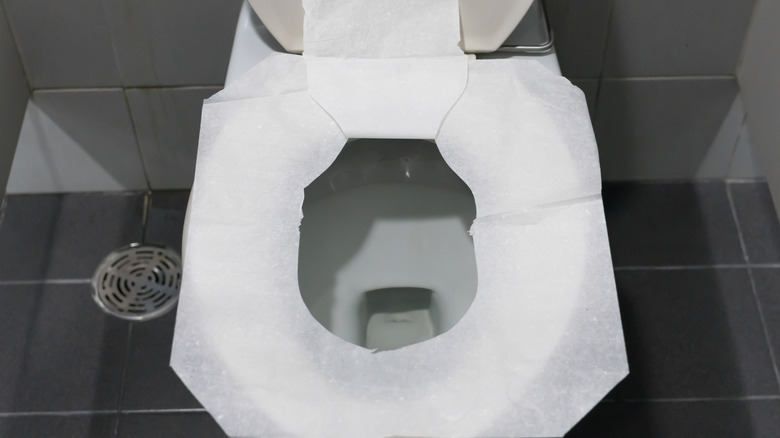The Toilet Habit Women Should Break Right Now (Yes, That Means You)
There are two types of "mom advice" we all grow up with and often pass on to our own children. The first is the commonsense wisdom we try to follow: Eat a good breakfast; take an umbrella; look both ways before crossing the street. Then there are the mom-isms that science has long debunked, like "don't read in dim light" (your eyes may be uncomfortable, but they won't be ruined) or "don't go outside with wet hair" (you won't catch a cold). Surprisingly, though, there's one well-known piece of motherly wisdom that sounds smart but could actually end up doing more harm than good.
When nature calls on a trip or in a restaurant, odds are you remember Mom's cautions about the cleanliness of public toilets. It's filthy! You don't know what kind of diseases you might catch! So you take special care not to let your bottom touch the seat; perhaps you even use your foot to push the flush handle. But in truth, a toilet seat isn't the grim health hazard you were taught to believe. According to Banner Health, the average toilet seat has only about 50 bacteria per square inch — compare that to the 45 billion bacteria in the average kitchen sponge. Even your spice rack is an inconspicuous germ magnet in your kitchen because people often touch the bottles after handling raw meat or vegetables. More importantly, though, using the familiar over-the-toilet pose in a public restroom is actually more harmful than sitting down.
The hover position takes a toll on your body
Women everywhere are all too familiar with the routine of squatting and hovering over a public toilet to avoid touching the seat when they pee. But physical therapist Stephanie Bobinger of The Wexner Medical Center at Ohio State University puts it bluntly: Don't hover. While it may seem like the most sanitary option, it's actually horrible for your body. When you're poising yourself over the seat, you're also tensing your pelvic floor, the bottom group of muscles at the abdominal core that support the back, stomach, and internal organs. This makes it all but impossible to empty your bladder normally. As a result, you may strain harder to get every drop out.
Over time, straining the pelvic floor may lead to dysfunction of the muscles, per the Cleveland Clinic. When that happens, you may suffer constipation, frequent bathroom visits, incontinence, and pain. The other risk of hovering is that some urine may remain and irritate your bladder, leading to a painful UTI or a sense that you need to go urgently even when you don't. It's a high price to pay for the temporary sense of safety you may feel over not sitting on the toilet. (Crossing your legs can also weaken your pelvic floor, so try not to sit in that position for too long.)
When in doubt, cover the seat
Contrary to what you may have heard as a child, your risk of catching a serious infection from a public toilet seat is pretty low. Apart from the fact that restaurants and other public places clean their bathrooms daily, the germs that land on the seat don't tend to live very long. Plus, our skin naturally acts as a barrier against infection; bacteria can only enter through a break in the skin or through a natural opening in the body.. Unless you have an open cut on your bottom, or your genitals make direct contact with the seat, you're not likely to pick up anything nasty from sitting directly on the loo. If the seat is wet, simply wipe it off, or use a flushable seat cover if available. (There's also Mom's old trick of covering the seat with toilet paper.)
Other than sitting to pee, the most important thing you can do in the bathroom to avoid illness is to wash your hands thoroughly with soap every time. Be sure to scrub for 20 seconds before rinsing. Use a paper towel to turn off the faucet afterward so you don't re-contaminate your hands. Then you can go on to follow some of Mom's more accurate advice — like eating your vegetables.


